Improving wellbeing in the workplace has been proven to increase employee engagement, satisfaction, and productivity.
It gives your workforce the confidence to bring their A-game to the table. They are able to address physical and mental health concerns and strike the best balance between their work and home lives.
Read on to discover how you can introduce effective wellbeing initiatives to your company, helping to create a happy and healthy workforce.
The importance of wellbeing at work
Employee wellbeing is increasingly viewed by leading organisations as crucial to the overall success of the company. In the wake of the pandemic, introducing initiatives to promote the physical and mental health of employees is more important than ever.
The study from the National Center for Biotechnology Information, Well-Being in Life and Well-Being at Work: Which Comes First? summarises the importance of workplace wellbeing as part of a holistic approach to wellbeing, saying:
“We concede that work is just one arena to enhance well-being, however, given the amount of time spent at work across our lifetimes, seemingly a powerful one. Therefore, understanding the well-being ecosystem for impact areas and reciprocal relationships in life and at work is important to finding ways to intervene. Without this holistic view, the leverage points for optimizing well-being may be invisible or inadequate by an overemphasis or attribution to one sphere of influence only.”
As an employer, you can have a limited impact on factors that influence wellbeing outside of the workplace. However, there is a range of avenues you can explore to encourage workplace wellbeing.
Additionally, approaches can be taken to help employees who are working remotely to improve their overall health and wellbeing.
This article will consider a range of methods that can be adopted in the workplace to help encourage an environment where wellbeing is prioritised. This includes:
- How to promote health and wellbeing in the workplace
- How to improve levels of wellbeing throughout your workforce
- What benefits employees – and the company – can expect from an effective wellbeing strategy
- Ideas you can try yourself which promote health and wellbeing
Promoting health and wellbeing at work
There are a variety of communication strategies businesses can adopt in order to promote health and wellbeing at work. By using a multi-channel communications platform, you can ensure these promotions reach everyone, including remote working staff who otherwise might feel out of the loop.
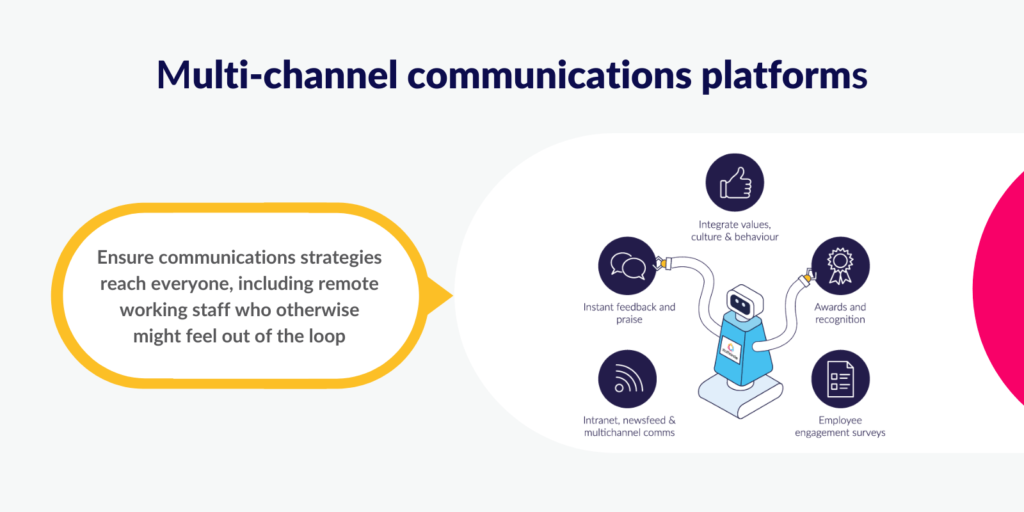
Try some of these ideas to better promote health and wellbeing at work:
Exercise and fitness class promotions
Exercise and fitness classes are an obvious way to help employees improve their physical and mental health. It’s easy to promote these in the workplace. You can use your company’s forums to set up notice boards for a range of classes, encouraging employees to share suggestions too. This could include anything from break time yoga sessions to lunchtime walks or bike rides. You can also help to initiate activities that can take place outside of the workplace, over weekends or in the evenings.
Awards and recognition programs
Recognition for a job well done encourages employees to improve their performance and can be enhanced through awards and recognition programs. Some performance management software allows users to rate one another’s performance. Whether they’ve delivered a solid presentation or completed an assignment to a high standard, their coworkers can show appreciation.
Use these awards and recognition programs to create a constant flow of positive feedback within teams, departments, and the wider workforce.
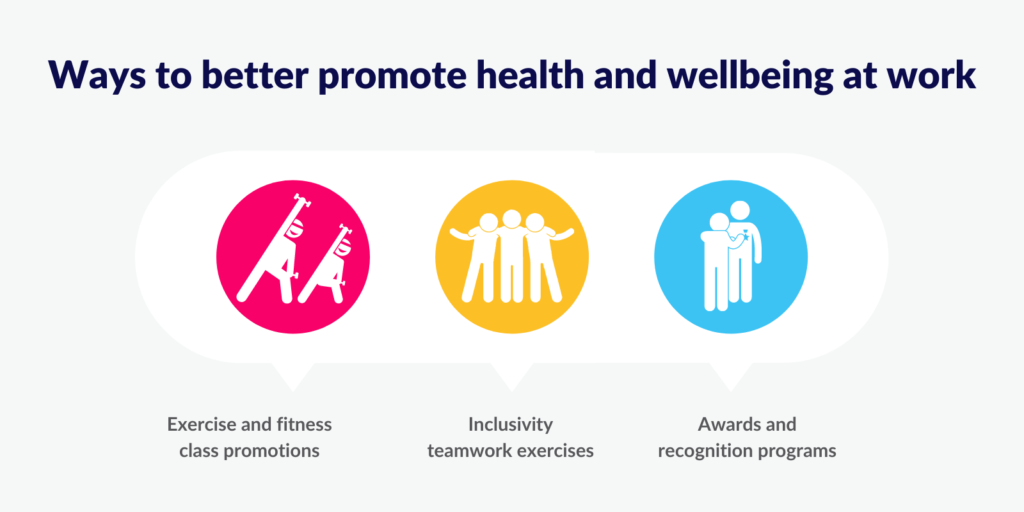
Inclusivity teamwork exercises
When an employee feels disconnected from their colleagues, their wellbeing is likely to be affected. Positive team dynamics, in which each member feels included, is an essential component of employee wellbeing.
In an interview with Forbes magazine, Michael Fenlon, Chief People Officer, at PwC, observed how teamwork plays into wellbeing initiatives:
“One of the things we’ve learned from doing this work is don’t go at it alone. In other words, the magic resides in teams, in creating that sense of community. So yes, while we are providing information to individuals and asking people to opt-in and build their own personal plan, really the power resides when we’re doing this socially in teams.”
There are a range of team-building exercises you can set up to help promote this sense of community and promote a healthy level of inclusion in the workforce.

How can we improve wellbeing in the workplace?
There are several approaches business leaders can take to help improve wellbeing in the workplace. Consider adopting the following measures:
Encourage employees to discuss their concerns
One of the biggest problems many have with addressing health and wellbeing issues is the inability to face up to them. Employees who are feeling anxious or depressed often keep this to themselves, when they could benefit from frank and open discussions about their problems.
Encouraging your workforce to speak openly about issues is the first step to addressing them. This could be a conversation with their team leader or manager, or it could be a meeting with the company’s occupational health representative. Put measures in place so that your employees have someone to talk to should they feel the need.
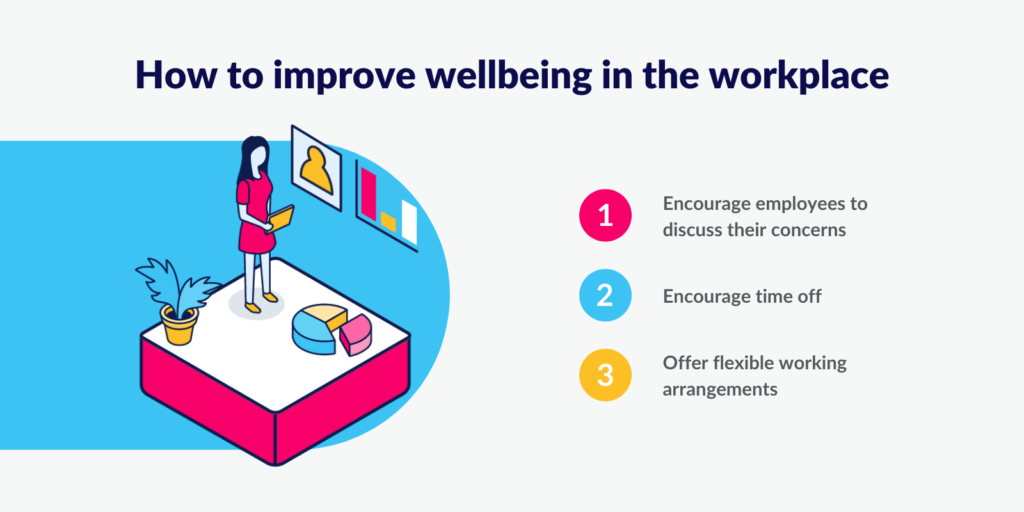
Encourage time off
Employees, especially those who are driven to perform highly, can avoid taking time off work. As a result, they can experience burnout. Make the effort to encourage staff who may class themselves as ‘workaholics’ to take more time off to relax and recuperate. Your HR team can help managers identify those who take infrequent holidays through their absence management software. You can then encourage those who are overworked to take time away to help them maintain a positive work/life balance.
Offer flexible working arrangements
Stress can come from a variety of sources. Employees may not have enough time to do the morning school run or need a flexible work arrangement to help look after a family member. You can help with these problems by offering flexible working arrangements. This allows your employees to improve their schedule, decreasing their stress and improving wellbeing.
What are the benefits of a wellbeing strategy?
An effective wellbeing strategy can help your employees overcome challenges in their personal and professional lives. This motivates them to perform at their best, giving them confidence in the company’s understanding of their physical and mental health.
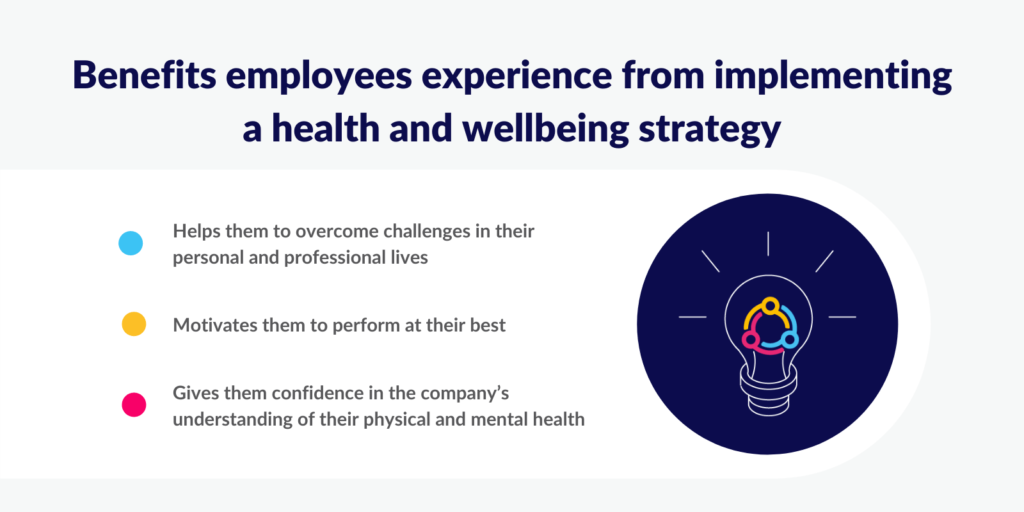
The benefits of a comprehensive wellbeing strategy aren’t limited to your employees. Benefits also impact the company at large, improving outcomes across a series of key metrics.
The detailed study of wellbeing in the workplace from Gallup, Wellbeing in the Workplace and Its Relationship To Business Outcomes, observes:
“The ability to promote well-being rather than engender strains and mental illness is of considerable benefit not only to employees in the community but also to the employer’s bottom line. The emotional well-being of employees and their satisfaction with their work and workplace affect citizenship at work, turnover rates, and performance ratings.”
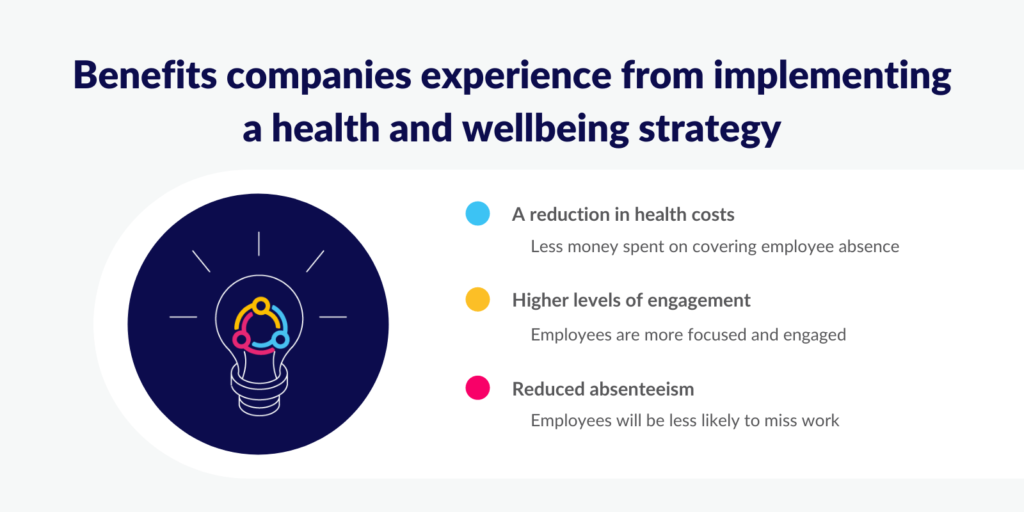
Other benefits companies can experience from a health and wellbeing strategy include:
- A reduction in health costs. Fewer members of staff taking time off to address physical and mental health concerns means less money spent on covering their absence
- Higher levels of engagement. Employees who are satisfied with their level of wellbeing are more focused on performing well and engaging positively with their work
- Reduced absenteeism. Employees will take fewer sick days and be less likely to miss work. A happy and healthy workforce enjoys participating in projects and work activities.
Health and wellbeing at work ideas
Here are some additional workplace health and wellbeing ideas you can implement to address employee wellbeing and build a happy and healthy workforce:
- Provide healthy snacks for employees
- Arrange a walking meeting
- Encourage colleagues to meet up informally
- Provide company perks that contribute to wellbeing
- Introduce company-wide meetings
- Start volunteering initiatives
- Resilience training sessions for improving personal development
- Introduce regular social events, such as Friday evening drinks or company lunches
- Engage with the local community
- Offer employees discounts for local gym memberships
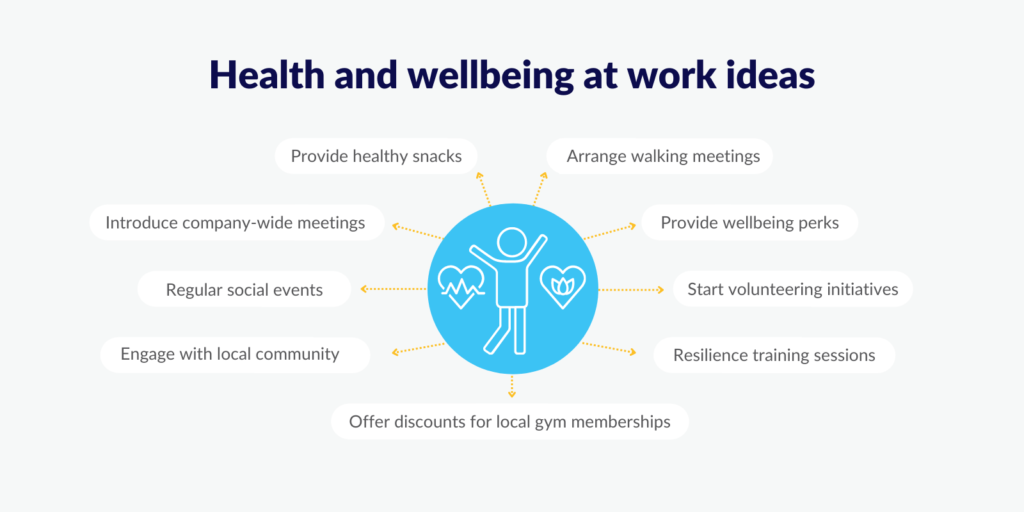
In Summary
Health and wellbeing initiatives are an essential element of a positive and productive workforce. This article should help you to put together a range of initiatives that can help boost mental and physical wellbeing, giving employees the opportunity to truly thrive in their roles.






